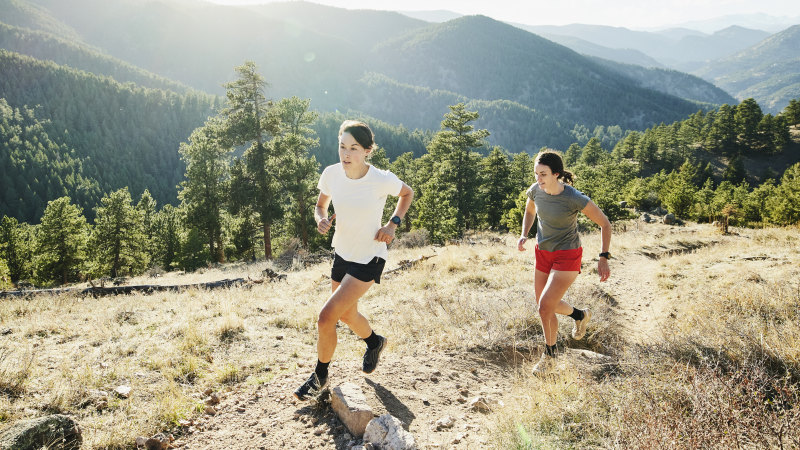[ad_1]
However, Green says that in comparison to road running “trail running is more forgiving on the body”. Most road running injuries are from overuse, taking the same step over and over again. While more hills on a trail can feel harder on the muscles, the variety of terrain at a slower pace means it’s easier on the joints.
Loading
Strength and stability training can also assist in preventing injury. The Body Mechanic blog frequently posts strength, stability and flexibility exercises to do at home, but Green says lunges are one of the most effective.
“I encourage people to do somewhere between 30 and 50 walking lunges, either at the start of a run or the end of a run to stretch out your hips and it makes your glutes stronger.”
Green also highly recommended taking a snake or compression bandage. “Anytime in summer, people should really be running on trails with snake bandages,” he says.
The bandage is also useful for injuries, says Green. If you do sprain an ankle you need to be self-sufficient at getting yourself back to civilisation.
Green, who would rather run on a trail for five hours than five minutes on the road, acknowledges his bias but encourages anyone interested to give it a crack.
“I think if anyone’s thinking they should give it a go or their normal running is boring or stressful, then jumping into some trails could be a massive game changer.”
How to find trails to run
- Trail Run Project is a free app that allows you to explore trail runs near you. AllTrails and Strava are similar paid apps that feature trails and bush walks completed by others.
- National Parks want you to enjoy the great outdoors and are a good starting point to find trails nearby. The NSW and Victoria National Parks websites have suggested walks with difficulty grading and distance. If you can walk it, you can run it.
- Try looking for Facebook groups of local trail-running enthusiasts who can suggest tracks or facilitate group runs. If you can’t find any in your area, start your own!
Mentally preparing for the challenge
It’s no secret that running is a mental challenge.
To get your head around it, Squad Run running coach Ali Pottinger says to celebrate the little things.
“We can be a bit risk-averse about stepping out into the unknown,” says Pottinger. “Check out some short local trails and be proud of yourself for embracing adventure and challenge.”
So, slow down and smell the eucalyptus. Trail running is an opportunity to get outdoors, once you have a few trails under your belt find your motivator. Pottinger suggests getting inspired through setting personal bests, exploring a new or favourite route or socially running with others.
Trail running can be a mood booster and a good problem-solving test, says Samantha Gash, mind coach and co-founder of female-focused community Her Trails, which hosts free weekly group trail runs around Australia.
Loading
“Navigating varied terrains and conditions demands real-time mental engagement and adaptation … The immersive experience in nature can deepen your sense of mindfulness, helping to cultivate a lasting state of mental clarity and reduced anxiety,” says Gash.
Putting yourself under healthy stress can also help build mental resilience. Gash says this involves being realistic when setting goals and allowing yourself to be patient when building new skills.
Beginners can come up against mental barriers such as low confidence, high anxiety or putting too much pressure on themselves. Take a holistic approach to your training by considering your mindset.
“Mentally preparing for trail running involves embracing the natural unpredictability of the terrain … you should think of it as a version of play,” says Gash.
Feeling isolated can be a side effect of running alone in remote places, so Gash recommends joining a running group or club. Running with others can help dampen nerves, keep motivation high and is a great way to make friends.
“These groups not only combat feelings of isolation but also offer encouragement and shared experiences,” says Gash.
Submerging yourself in the trail running community is something Pottinger also recommends. “The trail running community is super welcoming and supportive so reach out to a run club or a good coach,” she says. Try searching for local trailing running or hiking groups on Facebook.
Getting yourself into the right gear
One possible reason I rolled my ankle was because I was wearing the wrong shoes.
Blue Mountains Running Co head manager Leigh Hawker says trail shoes are durable for rough terrain with a lower profile and more grip than road running shoes.
“It’s really about comfort and what works for your feet … Make sure that your shoe is secure around the ankle and there is enough space at the front of your shoe, usually a thumbnail width,” says Hawker, who recommends getting fitted by a specialist.
Besides shoes, one of the other investment items that is nice to have is a running watch. Watches can track your pace, distance and even your recovery time.
“They can also navigate where you’re going so you can’t get lost in nature,” says Hawker.
Loading
Hydration is important for any run. If you are heading out on a long run think about how you are going to carry water. Hawker says the Salomon Adv Skin 12 is their most popular running pack with room for water bladders and pockets for snacks.
Safety is the number one priority. Hawker recommends taking a head torch for running in low visibility. If you are running into a particularly isolated location consider taking a personal locator beacon, which can be hired (usually for free) from National Parks centres.
“Always let people know where you’re going if you’re going by yourself into the National Parks, respect any parks closures and leave no trace,” Hawker says.
Make the most of your health, relationships, fitness and nutrition with our Live Well newsletter. Get it in your inbox every Monday.
[ad_2]
Source link

